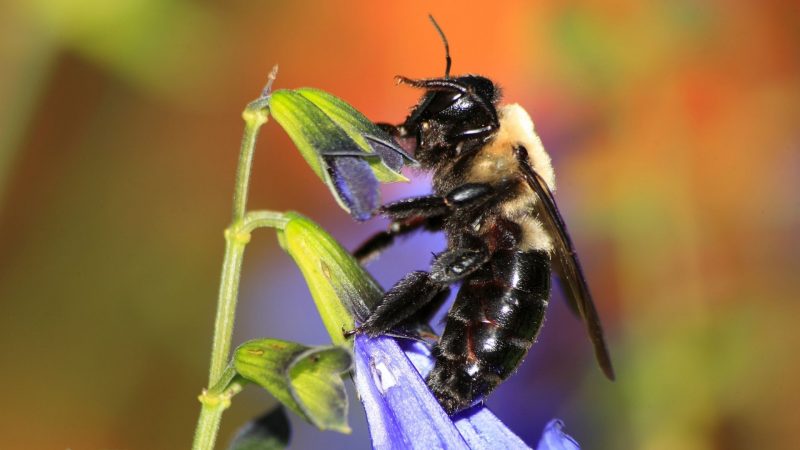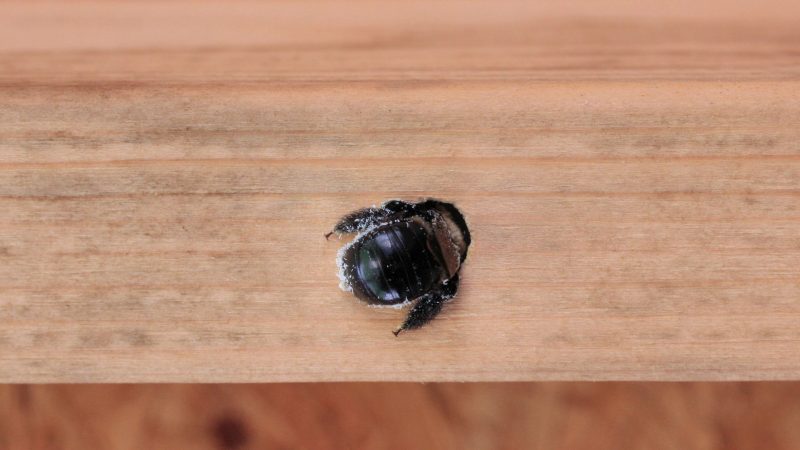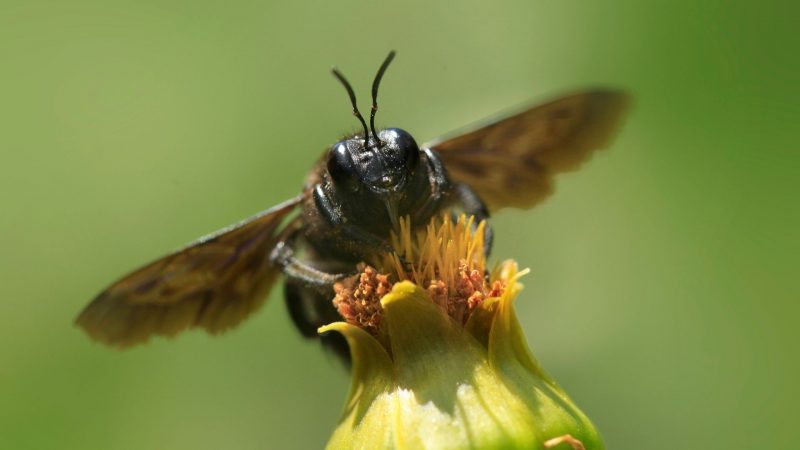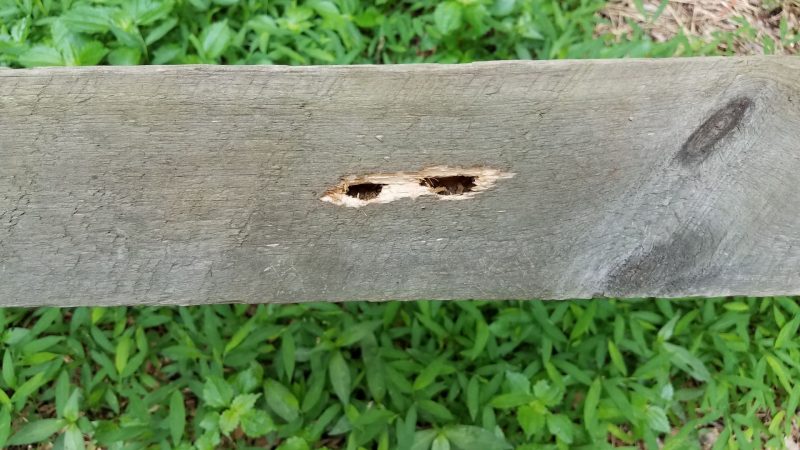Do you always wonder why the wood structures at your homes are constantly filled with holes and excavations? If yes, then you might probably be infested with carpenter bees. It’s important to distinguish between male and female bees to know what you’re dealing with.
What is the difference between a male and a female carpenter bee? The male’s head marking is white while a female is black. The female is stinging when provoked and can cause more damage since they regularly burrow holes in woods to make nests and lay eggs. Whereas males defend their territory through dive-bombing and are primarily engaged in nectar robbing.
To further acquaint ourselves with these nectar-robbing, hole-drilling bees, keep reading to continue discovering their nature, traits, and habits, ways to get rid of them, the signs of infestation and damage, and the effective remedies in exterminating them.
What Do Carpenter Bees Look Like?

Carpenter bees usually have similar appearances with bumblebees, although the latter are larger in size when mature. They commonly have shiny looks with a body-color ranging from metallic blue or black to a purplish or greenish tinge. They also have hairless abdomen, but their rear legs have a dense set of hair.
Related: Carpenter Bee and Bumblebee | Is There Any Difference?
How Do You Tell the Difference Between a Male and a Female Carpenter Bee?
The following are the differences between a male and a female carpenter bee as to size, color, wings, level of aggression, ability to sting, and threat:
| Male Carpenter Bees | Female Carpenter Bees | |
| Size | Usually same in size; ¾ inch to 1 inch. | Usually same in size; ¾ inch to 1 inch. |
| Color | Metallic blue or black with a purplish or greenish luster. However, there are certain male breeds that are covered with yellowish or greenish fur; head markings are white in color. | Metallic blue or black with a purplish or greenish luster; head markings are purely black in color. |
| Wings | Wing venation is characteristic of the genus Xylocopa. | Wing venation is characteristic of the genus Xylocopa. |
| Aggression | Generally aggressive as they have the task to protect their territories from intruders. | The level of aggression is usually lesser; would only be aggressive if they are thoroughly or overly provoked. |
| Sting | Do not have the ability to sting but can perform dive-bombing. | Can sting predators but only when placed in a dangerous situation. |
| Threat | Considered a threat most of the time since they are determined to protect their territories. | Not necessarily recognized as a threat since they are only considered a danger when put in a perilous place. |
Do Female Carpenter Bees Kill the Males?
Although the female carpenter bees have the ability to sting, they do not usually kill the males. They are always busy with nest-making, so most of their time is devoted to creating a space where they can properly lay eggs.
Do Female Carpenter Bees Come Out?

Carpenter bees go out during the spring season in order to find their mates. Once they have found their respective partners, the female carpenter bees will excavate on wood structures to establish their territories while the males will be stuck in defending their location.
Related: When Is Wasp Season? | Important Facts!
Why Are Male Carpenter Bees Aggressive?

Even though male carpenter bees do not have the capacity to sting, they are often found to be aggressive. This is because they are primarily responsible for defending their territories, specifically the sites being drilled by their female counterparts.
If a flying insect or a person comes within the vicinity of their territory, they would usually exhibit their defense mechanisms in order to ward off any predators. This includes their act of dive-bombing.
Do Male Carpenter Bees Drill Holes?
As a general rule, male carpenter bees do not drill holes as their focus is on protecting their mates and territories from predators. It is always the female carpenter bees who burrow wood and make holes on it for the purpose of cultivating the nest.
Should You Worry About Carpenter Bees?
Yes, specifically if they would constantly drill holes on the wood structures of homes, offices, or other establishments. The holes may expand to tunnels once another group of carpenter bees would continue digging on it. This may weaken the structural foundation of a building, affecting its overall integrity.
Also, carpenter bees may cause harm to people when provoked or when placed in a threatening condition. When they sting, a sharp pain and burning sensation may be felt if the bee venom is injected into the skin.
What Are the Signs of Carpenter Bees Infestation?
Common signs include a great prevalence of holes in wood structures. The excavations may measure at least ½ to one inch in diameter, and the tunnels that can be created may possibly reach 10 inches long. Additionally, the existence of sawdust-like areas can also be a sign of carpenter bees.
How to Identify Carpenter Bees Damage?

Unlike termites, carpenter bees do not eat wood but drill holes in order to build nests. Thus, in identifying any kind of damage, you must first look for wood craters and openings.
These holes are usually found in unpainted softwoods such as spruce, fin, and cedar but may also be present in fascia boards, dead tree trunks, wood railings, telephone poles, decks, wood fences, and outdoor spaces furniture.
The level of damage may depend upon the depth and size of the holes. Thus, regular checking and assessment of these areas must be done to determine whether the degree of damage is escalating or decreasing.
How to Get Rid of Carpenter Bees Fast?
In order to get rid of carpenter bees immediately, you can make use of insecticide dust, foaming aerosols, and bee sprays that can effectively exterminate the said insects.
These pesticides contain hazardous substances such as permethrin, cypermethrin, bifenthrin, and tetramethrin, which can potently kill insects such as carpenter bees.
Apply insecticide sprays and dust on the holes. Then, allow the tunnels to be open for several days so that the carpenter bees will have the chance to touch them upon their return. In applying these mixtures, extreme caution must be employed since it may cause irritation on the skin.
What Home Remedy Kills Carpenter Bees?
Carpenter bees can be killed by applying natural ingredients and home remedies. Examples of these are the use of pyrethrum, a flower that is commonly utilized in pesticides.
Another one is boric acid, a household item that can be transformed into an insecticide by mixing one part of this substance with three parts of water.
Related: Powerful Homemade Wasp and Bee Sprays (with Recipes)
How Do You Keep Carpenter Bees Away Without Killing Them?

The following are the effective ways of keeping away carpenter bees without killing them:
- Put paint, polyurethane, or varnish on the wood surfaces since carpenter bees are most attracted to unpainted wood.
- Replace damaged wood parts with chemically treated wood or synthetic materials to prevent carpenter bees from swarming or returning on it.
- Place commercial or homemade traps in order to control the movement of carpenter bees.
- Plug the holes made by carpenter bees with wood putty or caulking compounds.
- Incorporate essential oils such as tea tree, lemon, and peppermint on the infestation site as carpenter bees are sensitive to these odors.
- Create noises such as music from speakers or radios near the location of carpenter bees as they abhor loud sounds and prefer quiet moments.
Related: Carpenter Bee Control: How To Get Rid of Carpenter Bees?
List of Sources
Gibb, T. (2018). Household & Structural: Carpenter Bees.
Jacobs, S. (2017). Carpenter Bees.
Jurong Lake Gardens, National Parks. (2020). Carpenter Bees of Jurong Lake Gardens.
Missouri Department of Conservation. (n.d.). Eastern Carpenter Bee.
Potter, M. (2018). Carpenter Bees.
- Bed Bug Surge 2025: How to Detect, Prevent, and Safely Eliminate Infestations in Top U.S. Cities - June 18, 2025
- Asian Needle Ants Invade US Homes: 2025 Guide to Identification, Risks, and Effective Control - June 11, 2025
- New World Screwworm Alert: How US Livestock Owners Can Prevent Outbreaks and Protect Herds [Summer 2025 Update] - June 8, 2025
